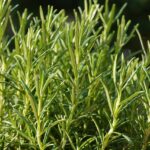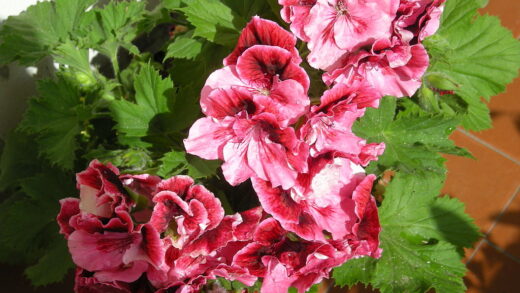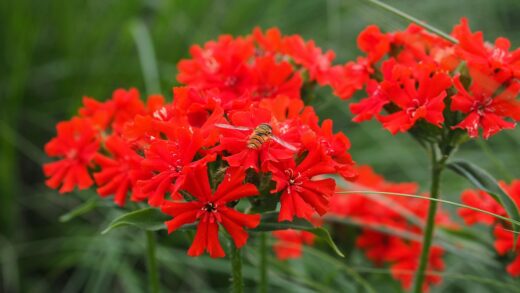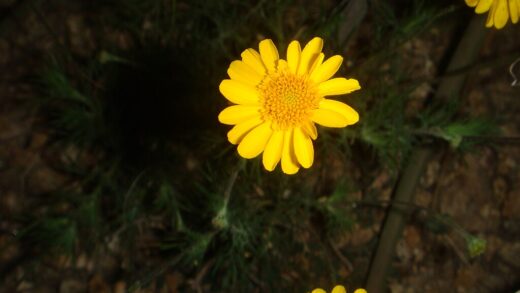The diseases and pests of the dahlia
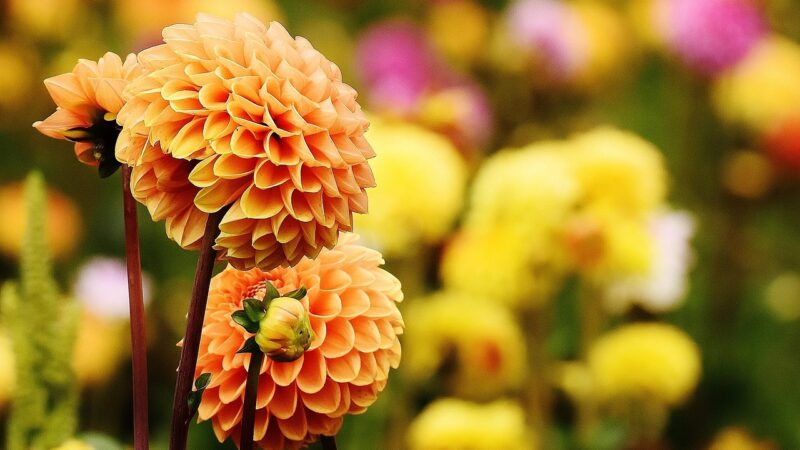
While dahlias are generally robust and vigorous plants, they are not immune to the challenges posed by various diseases and pests. A vigilant gardener who can identify and address these issues promptly will be far more successful in maintaining a healthy and beautiful dahlia patch. Problems can range from common fungal diseases like powdery mildew, which thrive in certain weather conditions, to sap-sucking insects like aphids and thrips that can weaken the plant and spread viruses. Understanding the signs and symptoms of the most common ailments and knowing the best strategies for prevention and control are essential skills for anyone serious about dahlia cultivation. A proactive, integrated approach to pest and disease management will always yield the best results.
Common fungal diseases
Fungal diseases are among the most common problems affecting dahlias, with powdery mildew being the most frequently encountered. This disease appears as a white or grayish powdery coating on the surfaces of leaves, stems, and sometimes flowers. It typically thrives in conditions of high humidity, warm days, and cool nights, making it a common sight in late summer and autumn. While it may not kill the plant outright, a severe infection can reduce photosynthesis, stress the plant, decrease bloom production, and cause leaves to yellow and drop prematurely. Prevention is the best strategy, and it starts with providing good air circulation by properly spacing the plants and pruning out excess foliage from the lower parts of the plant.
Another fungal issue that can affect dahlias is gray mold, or botrytis blight. This disease often appears during cool, damp weather and typically attacks the flowers and buds, causing them to turn brown, rot, and become covered in a fuzzy gray mold. It can also affect stems and leaves, causing soft, brownish lesions. To manage gray mold, it is crucial to practice good garden sanitation. Promptly remove any infected blooms or plant parts to prevent the spores from spreading, and avoid overhead watering, which can leave the dense flower heads wet for extended periods. Ensuring good air circulation around the plants is also a key preventive measure.
Tuber rot is a significant concern for dahlia growers and is usually caused by soil-borne fungi or bacteria that thrive in anaerobic, waterlogged conditions. This is why excellent drainage is so critical for dahlias. The rot can occur either in the ground during the growing season due to overwatering or poor drainage, or during winter storage if the tubers are not cured properly or are kept in a damp, poorly ventilated environment. A rotting tuber will become soft and mushy and emit a foul odor. Once a tuber starts to rot, it cannot be saved and should be discarded to prevent the spread of the pathogen to other healthy tubers.
To prevent fungal diseases, a proactive approach is always more effective than a reactive one. Start with healthy, disease-free tubers from a reputable source. Ensure plants are not crowded and have good airflow. Water at the base of the plant to keep the foliage dry, and maintain good garden hygiene by removing and disposing of any diseased plant material. For persistent problems with powdery mildew, applications of a fungicide, either organic options like neem oil or potassium bicarbonate, or a conventional fungicide, can be effective if applied at the first sign of the disease.
More articles on this topic
Destructive insect pests
A variety of insect pests can plague dahlia plants, causing damage by feeding on the leaves, stems, and flowers. Aphids are one of the most common culprits. These small, pear-shaped insects cluster on new growth and the undersides of leaves, using their piercing mouthparts to suck sap from the plant. A heavy infestation can cause distorted growth, yellowed leaves, and a sticky residue known as honeydew, which can in turn lead to the growth of sooty mold. Aphids are also notorious vectors for spreading plant viruses, making their control particularly important.
Spider mites are another sap-sucking pest that can be very destructive, especially in hot, dry conditions. These tiny arachnids are difficult to see with the naked eye, but their damage is identifiable by a fine stippling or speckling on the leaves, which may eventually turn bronze or yellow and drop off. In severe infestations, fine webbing may be visible on the plant, particularly on the undersides of leaves. Regular inspection is key to catching spider mite populations early. Increasing humidity by spraying the plants with water can help deter them, as they prefer dry environments.
Thrips are tiny, slender insects that can cause significant damage to dahlia flowers. They feed by scraping at the petals and leaves and sucking up the exuded juices, which results in silvery streaks, distorted petals, and brown edges on the flowers. They can also prevent buds from opening properly and are another vector for plant viruses. Thrips are notoriously difficult to control because they often hide deep within the flower buds. Blue or yellow sticky traps can be used to monitor their populations, and controlling nearby weeds can help reduce their numbers.
Slugs and snails can be particularly devastating to dahlias, especially when the plants are young and tender. These mollusks are active at night and on damp, overcast days, chewing large, irregular holes in the leaves and sometimes consuming entire young shoots down to the ground. Their presence is often confirmed by the silvery slime trails they leave behind. There are numerous control methods, including hand-picking them at night, using beer traps, surrounding plants with a barrier of crushed eggshells or diatomaceous earth, or using commercially available slug baits.
More articles on this topic
Understanding viral diseases
Viral diseases pose a serious threat to dahlias because, unlike fungal diseases or pest infestations, there is no cure for an infected plant. Once a dahlia has a virus, it is infected for life, and the virus will be present in all its parts, including the tubers. The most well-known is the Dahlia Mosaic Virus, but several other viruses can also infect the plants. Viruses are typically spread from one plant to another by sap-sucking insects like aphids and thrips, or through mechanical means, such as using contaminated tools for pruning or taking cuttings.
The symptoms of a viral infection can be highly variable and sometimes subtle, making diagnosis difficult. Common symptoms include mosaic patterns of light and dark green on the leaves, yellow spotting or streaking, leaf distortion or curling, and stunted or twisted growth. The overall vigor of the plant is often reduced, and flower production may be poor. In some cases, an infected plant may show no symptoms at all, becoming a silent carrier that can spread the virus to other healthy plants in the garden.
Because there is no cure, the management of viral diseases is entirely focused on prevention. The single most important step is to be ruthless in removing and destroying any plant that shows symptoms of a virus. Do not add infected plant material to your compost pile, as this can perpetuate the problem. The entire plant, including the tuber, must be disposed of. This may be difficult for a gardener to do, especially with a beloved variety, but it is essential for protecting the rest of the collection.
Vigilant pest control is the second pillar of virus prevention. By managing the populations of sap-sucking insects like aphids and thrips, you can significantly reduce the risk of viruses being transmitted between plants. It is also crucial to practice good tool sanitation. When you are taking cuttings, dividing tubers, or even just deadheading, be sure to sterilize your pruners or knife between each plant. This can be done by wiping the blades with a disinfectant wipe or dipping them in a solution of bleach or rubbing alcohol. Starting with certified virus-free stock from reputable suppliers is also a key strategy for maintaining a healthy dahlia garden.
Integrated pest management strategies
Integrated Pest Management (IPM) is a holistic and sustainable approach to managing pests and diseases in the garden. Rather than immediately reaching for a chemical spray, IPM focuses on long-term prevention and uses a combination of different control methods. The foundation of IPM is to create a healthy garden ecosystem where plants are less susceptible to problems in the first place. This includes choosing resistant varieties, providing optimal growing conditions such as proper sunlight and well-drained soil, and ensuring plants are not stressed by improper watering or fertilization.
Regular monitoring is a cornerstone of any effective IPM program. This means spending time in your garden on a regular basis, closely inspecting your dahlia plants for any early signs of trouble. Check the undersides of leaves, the new growing tips, and the flower buds. The earlier you can detect a pest or disease, the easier it will be to control it before it becomes a major problem. For example, a small colony of aphids can often be simply wiped off by hand or washed off with a strong jet of water if caught early, eliminating the need for any kind of spray.
IPM encourages the use of biological controls, which involves leveraging the natural enemies of pests. You can encourage beneficial insects like ladybugs, lacewings, and hoverflies—which prey on aphids—by planting a diversity of flowering plants that provide them with nectar and pollen. Avoiding the use of broad-spectrum chemical pesticides is crucial, as these will kill the beneficial insects along with the pests, often leading to a resurgence of the pest population once the natural predators are gone. In some cases, you can even purchase and release beneficial insects into your garden.
When control measures are necessary, an IPM approach prioritizes the least toxic options first. This could include physical controls like hand-picking slugs or using barriers, or horticultural controls like proper pruning to improve air circulation. If a spray is needed, start with softer, more targeted options like insecticidal soap or neem oil, which have a lower impact on beneficial insects and the environment. Chemical pesticides are considered a last resort, to be used sparingly and only when a pest problem poses a significant threat to the health of the plants and other methods have failed.
Prevention as the best defense
When it comes to managing diseases and pests in the dahlia garden, the old adage that an ounce of prevention is worth a pound of cure holds true. The most effective strategy is to create an environment where your plants are so healthy and vigorous that they are naturally more resistant to problems. This preventative approach begins with the very foundation of your garden: the soil. Healthy, well-drained soil rich in organic matter supports a strong root system, which is the basis of a resilient plant. Conduct a soil test and amend as necessary to ensure your dahlias have the optimal conditions from the start.
Garden sanitation is a critical and ongoing aspect of prevention. This involves keeping the garden area clean and free of debris where pests and disease spores can overwinter. At the end of the season, be sure to remove all dead dahlia foliage and stalks from the garden rather than letting them decompose in place. Throughout the growing season, promptly remove any leaves or flowers that show signs of disease. Similarly, keeping the area around your dahlias well-weeded is important, as many weeds can act as host plants for common insect pests and viruses.
The quality of your initial planting stock plays a huge role in preventing future problems. Always purchase your dahlia tubers from reputable, trusted sources that are known for providing healthy, high-quality stock. Cheaper tubers from unknown sources may carry viruses or be prone to disease, introducing problems into your garden that can be difficult to eradicate. When dividing your own tubers, be meticulous about sanitation, sterilizing your tools between each clump to avoid spreading any potential pathogens from one plant to another.
Finally, cultural practices such as proper spacing and watering techniques are fundamental to disease prevention. Planting dahlias too close together restricts airflow, creating a humid microclimate that is a perfect breeding ground for fungal diseases like powdery mildew. Watering at the base of the plant in the morning, rather than overhead in the evening, allows the foliage to remain dry, making it a much less hospitable environment for fungal spores to germinate. By focusing on these preventative measures, you can create a robust dahlia garden that is better equipped to fend for itself.








